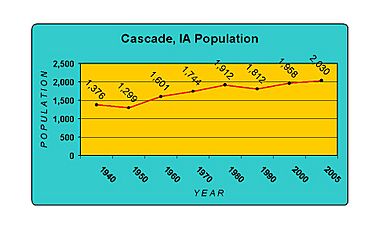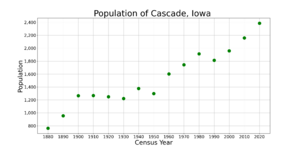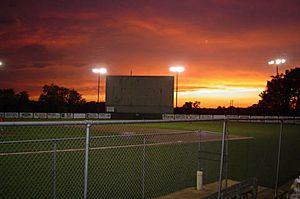Cascade, Iowa facts for kids
Quick facts for kids
Cascade, Iowa
|
|
|---|---|
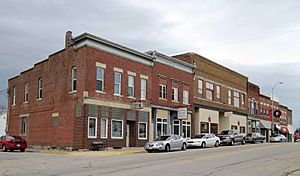 |
|
| Motto(s):
"The Place We Call Home"
|
|
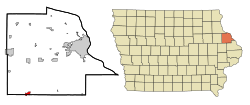
Location in Iowa
|
|
| Country | |
| State | |
| Counties | Dubuque, Jones |
| Area | |
| • City | 1.92 sq mi (4.97 km2) |
| • Land | 1.92 sq mi (4.97 km2) |
| • Water | 0.00 sq mi (0.00 km2) |
| Elevation | 827 ft (252 m) |
| Population
(2020)
|
|
| • City | 2,386 |
| • Density | 1,242.06/sq mi (479.65/km2) |
| • Metro | 92,384 |
| Time zone | UTC-6 (CST) |
| • Summer (DST) | UTC-5 (CDT) |
| ZIP code |
52033
|
| Area code(s) | 563 |
| FIPS code | 19-11305 |
| GNIS feature ID | 0455196 |
| Website | www.cascadeiowa.org |
Cascade is a city located in the state of Iowa, United States. It is found in both Dubuque and Jones counties. The part of Cascade in Dubuque County is near the Dubuque metropolitan area. The part in Jones County is near the Cedar Rapids metropolitan area.
In 2020, the city had a population of 2,386 people. This was an increase from 1,958 people in 2000. Cascade is in the southwestern part of Dubuque County and the north-central part of Jones County.
One important historical event for Cascade was a big flood in 1925. For many years, from 1880 to 1936, a special narrow-gauge railroad connected Cascade to Bellevue. This was the last narrow-gauge railroad in Iowa.
Today, U.S. Route 151 goes through Cascade. However, since 2002, a four-lane bypass helps traffic go around the city to the north. Iowa Highway 136 also runs through Cascade, going from north to south.
Contents
Exploring Cascade's Location
According to the United States Census Bureau, the city covers about 1.87 square miles (4.97 square kilometers) of land. There is no water area within the city limits. The North Fork Maquoketa River flows through Cascade.
Cascade is located about 25 miles (40 kilometers) southwest of Dubuque.
People of Cascade: Demographics
| Historical populations | ||
|---|---|---|
| Year | Pop. | ±% |
| 1880 | 762 | — |
| 1890 | 955 | +25.3% |
| 1900 | 1,266 | +32.6% |
| 1910 | 1,268 | +0.2% |
| 1920 | 1,249 | −1.5% |
| 1930 | 1,221 | −2.2% |
| 1940 | 1,376 | +12.7% |
| 1950 | 1,299 | −5.6% |
| 1960 | 1,601 | +23.2% |
| 1970 | 1,744 | +8.9% |
| 1980 | 1,912 | +9.6% |
| 1990 | 1,812 | −5.2% |
| 2000 | 1,958 | +8.1% |
| 2010 | 2,159 | +10.3% |
| 2020 | 2,386 | +10.5% |
| Source: and Iowa Data Center Source: |
||
Population in 2020
In 2020, Cascade had 2,386 people living in 970 households. About 630 of these were families. The city had about 1,242 people per square mile. Most residents (95.3%) were White. A small number of people were from other racial backgrounds. About 3.4% of the population was Hispanic or Latino.
About 32.3% of households had children under 18 living with them. The average age in Cascade was 40.2 years. About 26.3% of residents were under 20 years old. Also, 22.6% were 65 years or older. The population was almost evenly split between males (49.9%) and females (50.1%).
Population in 2010
In the 2010 census, Cascade had 2,159 people. There were 880 households and 578 families. The population density was about 1,154 people per square mile. Most people (96.2%) were White. About 3.6% of the population was Hispanic or Latino.
The median age was 38.7 years. About 26.2% of residents were under 18. About 19.4% were 65 or older. The city had slightly more females (51.0%) than males (49.0%).
Learning in Cascade: Education
Students in Cascade who attend public schools go to schools in the Western Dubuque Community School District. Younger students attend Cascade Elementary School for kindergarten through 5th grade. Older students go to the consolidated Cascade Junior-Senior High School for grades 6 through 12. Both of these schools are located in Cascade.
Cascade Elementary School was built in 1961. It has space for 420 students in 14 regular classrooms and two special education classrooms. The school added more space in 1993 and 2002. In 2017, 282 students attended the school.
Cascade also has private schools. Students attending parochial schools go to Aquin Elementary School in Cascade for grades K-8. Then, they attend Beckman High School in Dyersville for grades 9-12. These private schools are connected to the Roman Catholic Church. They are part of the Roman Catholic Archdiocese of Dubuque.
Famous People from Cascade
Many notable people have connections to Cascade. Here are a few:
- Gary Dolphin – A sports announcer for University of Iowa basketball and football games.
- Red Faber – A famous pitcher for the Chicago White Sox baseball team.
- Julie Hosch – A farmer and a state legislator in Iowa.
- Loras Thomas Lane – A Roman Catholic bishop.
- Greg McDermott – The head coach for the men's basketball team at Creighton University.
- William Menster – A Roman Catholic priest.
- Jeremie Miller – The person who started the Jabber project. He is also a board member of Bluesky.
- Colin Rea – A pitcher for the Milwaukee Brewers baseball team.
See also
 In Spanish: Cascade (Iowa) para niños
In Spanish: Cascade (Iowa) para niños


